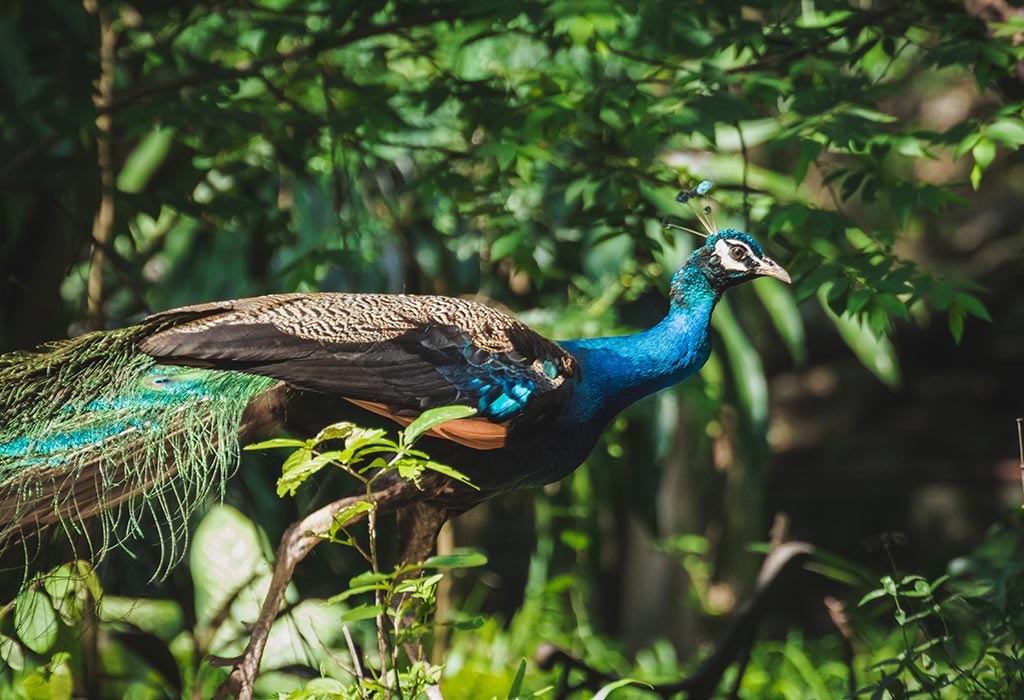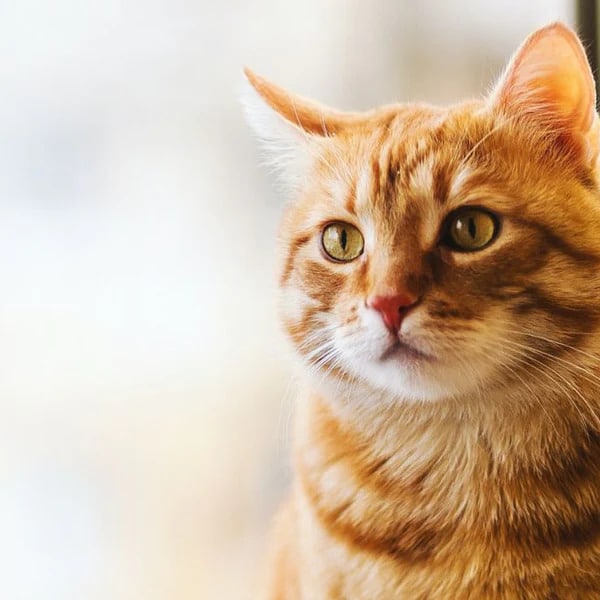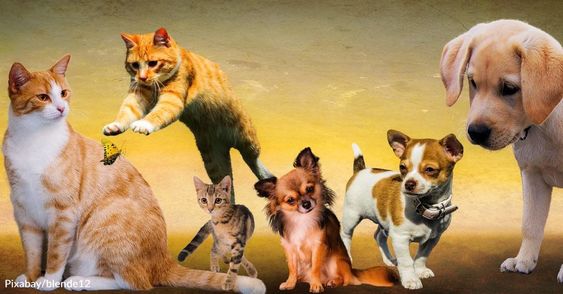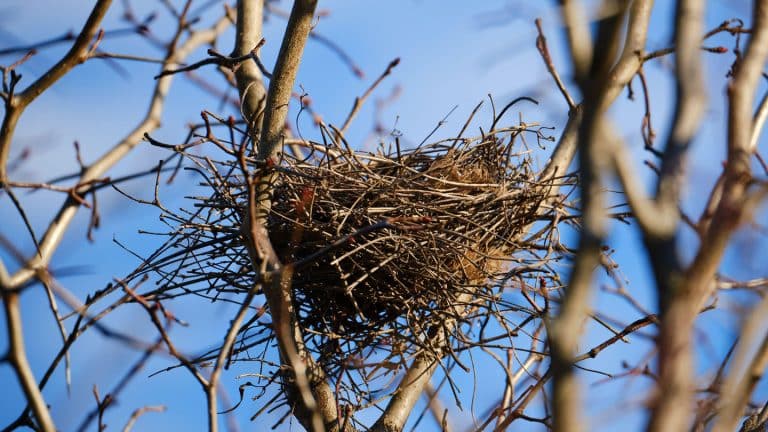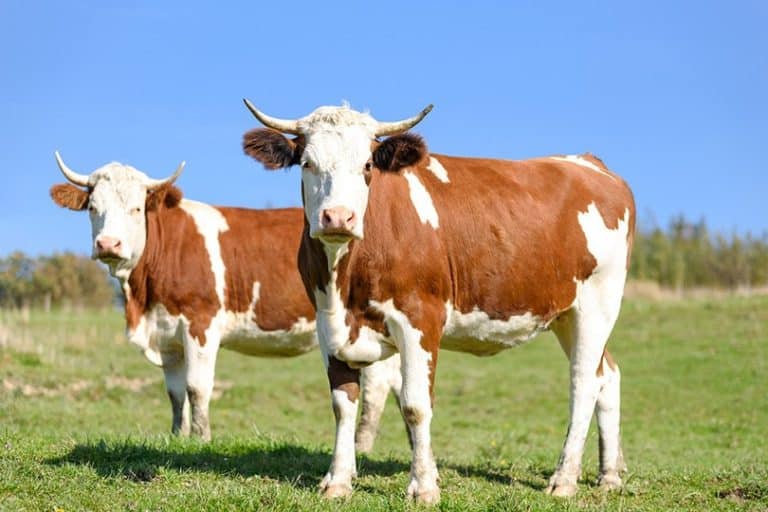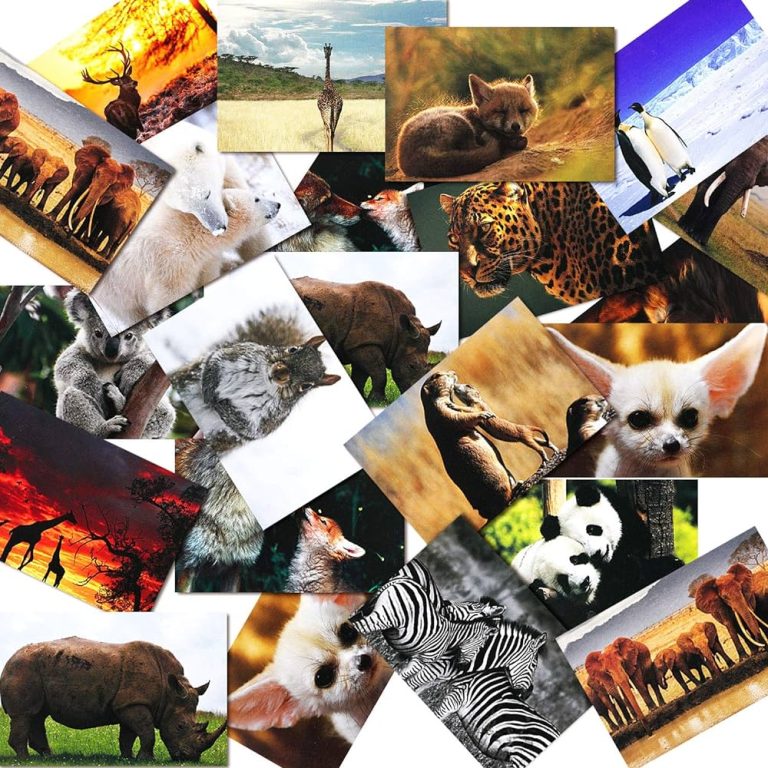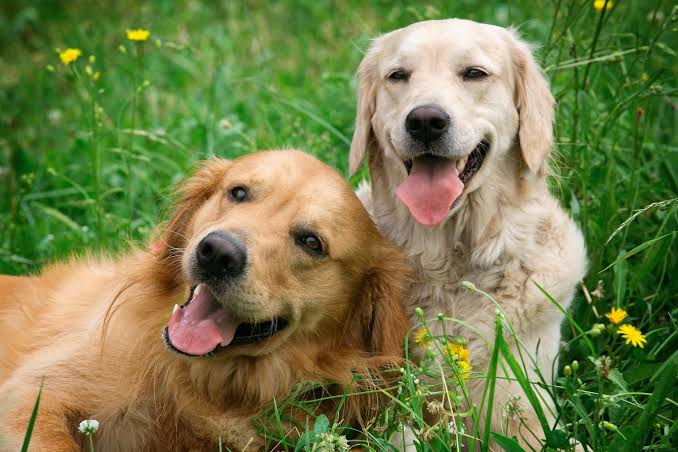Interesting Facts and Information About Peacocks
Are you fascinated to see peacock birds and want to know about their lifespan, characteristics, and diet? Peacocks are the most beautiful creatures created by God. They originated in India and symbolize royalty and beauty.
These majestic birds are also known as peafowls, and you can find their three prominent species, namely the African Congo peacock, the Indian peacock, and the Green peacock. They are admired worldwide because of their ornamental green and blue tail feathers that make them look distinct from the other birds.
The tail feathers of the male peacocks constitute about 60% of their total body length. Unlike other birds, they can’t fly for long periods. They mostly fly when they suspect threats or to fly up into trees or cross obstacles like rivers.
Peacocks also make excellent pets as they easily adapt to new environments and do not require extensive care to thrive well.
All You Need to Know About Peacocks
We bring some of the most interesting information and facts about peacocks. Check them out to broaden your knowledge about these majestic creatures.
What is a Peafowl Vs. Peacock?
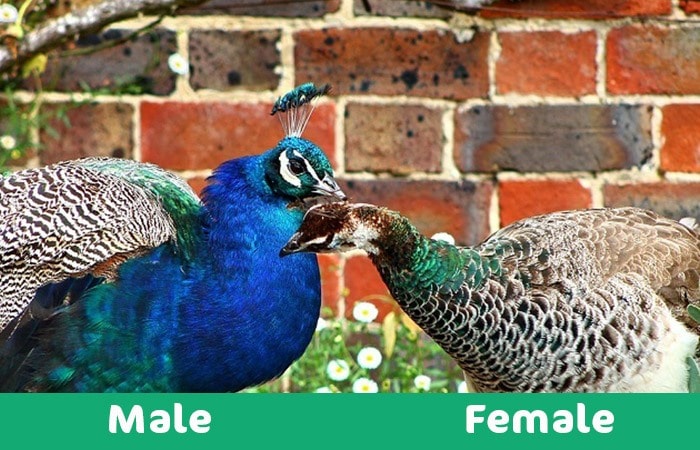
A peacock is not a bird species but a male peafowl. So, if you have been using the word peacock to address both female and male peafowl, then you’ll be surprised to know that it is technically incorrect. Peafowl is used for peahens and peacocks, but peacock is used only for male peafowl.
Peahens are females, and peacocks are males. Indian peafowl is the most popular peafowl species found in India and many other neighboring countries. They have green tail feathers with eye spots, a royal blue, long neck, and brown speckled patterns on their feathers.
The prominent difference between female and male peafowl is that only the males have colorful, large tails associated with peacocks. The most commonly found peacock breed is the blue peacock, native to India.
The best way to differentiate between a female and a male side-by-side is by looking at their tails. Female peahens don’t possess these tails, and their tail feathers look bland. Their plumage is duller, helping them evade predators by effectively camouflaging.
Another way to differentiate between them is by their size. Male peacocks are bulkier and larger than peahens. Male peacocks weigh around 4 to 6 kg, while females weigh around 2.75 to 4 kg. Peahens are 3 to 3.5 feet long, while peacocks are about 6 to 7 feet.
Females and males live together in small groups called harems or parties. A harem comprises several females and one male, whereas a party comprises a group of peahens or peacocks that are not mating.
Types of Peacock
There are mainly three types of peacock birds- Indian peafowl, Green peafowl, and Congo peafowl. Let’s take a look at each of them:
1. Indian Peafowl
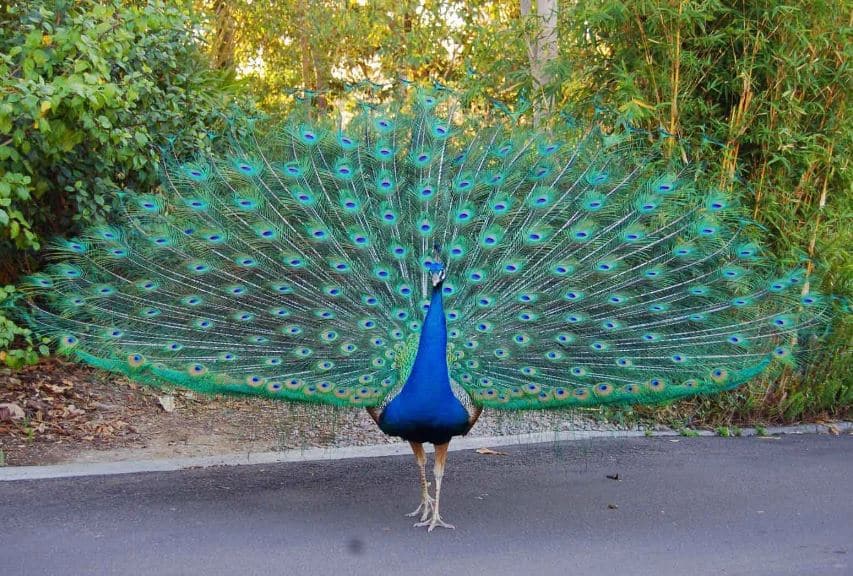
The Indian peafowl is the most popular peacock breed commonly found in Sri Lanka, India, and other neighboring countries. They are known for their bright blue crests and heads and beautiful tail plumage. This bright coloring and amazing tail plumage are only present in males, who use it to attract Peahens for mating. The male Indian peacocks have up to 5 feet long tails. You can see green and blue iridescent eyespots when the Indian peacocks spread their feathers.
Female Indian peahens are not as bright and colorful as the males. Their tail feathers and bodies are brown, and their chests are mottled white. Indian peafowl has been declared the national bird of India, and they are a highly protected bird species. It is illegal to eat or hunt Indian peafowl. They have also been introduced to other countries like Mexico as exhibits in nature centers, zoos, parks, or as domestic pets.
The Indian peafowl mainly live in open forests on the ground or on land under cultivation, where they prey on small rodents, snakes, and lizards and forage for grains and berries. When they detect any danger, like a tiger or any other predator, they make loud calls.
2. Green Peafowl
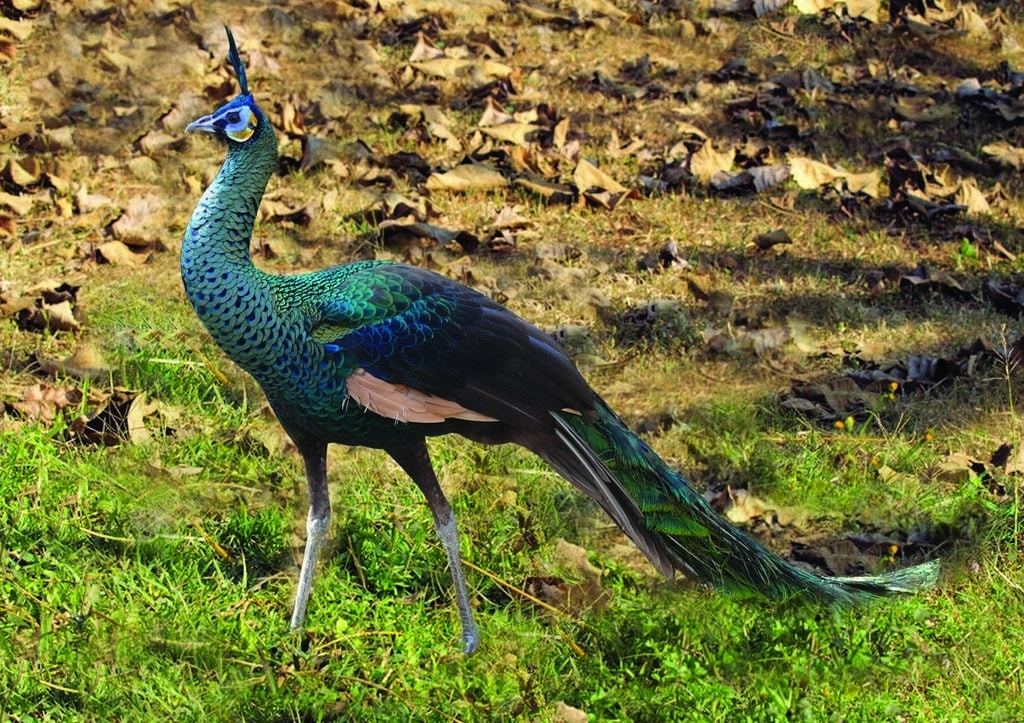
Green Peafowl shares lots of similarities with the Indian Peacocks. On their heads, they have fan-shaped crests like the Indian peacocks. They also have bright and vibrant tail feathers to attract females. The main difference is that their crests and heads are green in color rather than blue. They have double-striped facial skin with a whitish-blue appearance. A yellow-orange crescent can be found beside their ear. Below the eye, their dark triangle is brown in the female and bluish-green in the male. If you see them from a distance, they appear to be dark-colored birds with buff-colored primaries or pale vermillion that are visible when they take flight.
The Green Peafowl is known to be the most well-behaved and silent among the Peafowl breeds. Despite their large size, they are known for their capability to take extended flight. Among all the Peafowl breeds, they are the largest. Their tail is longer than the Indian Peacock.
Green peafowl is polygynous, meaning the male mates with many females. But in captivity, Green peacocks are monogamous, meaning one peahen form a bond and mate with each other for their entire life. Green Peafowl have been declared an endangered species, so it’s illegal to eat or hunt these majestic birds.
3. Congo Peafowl
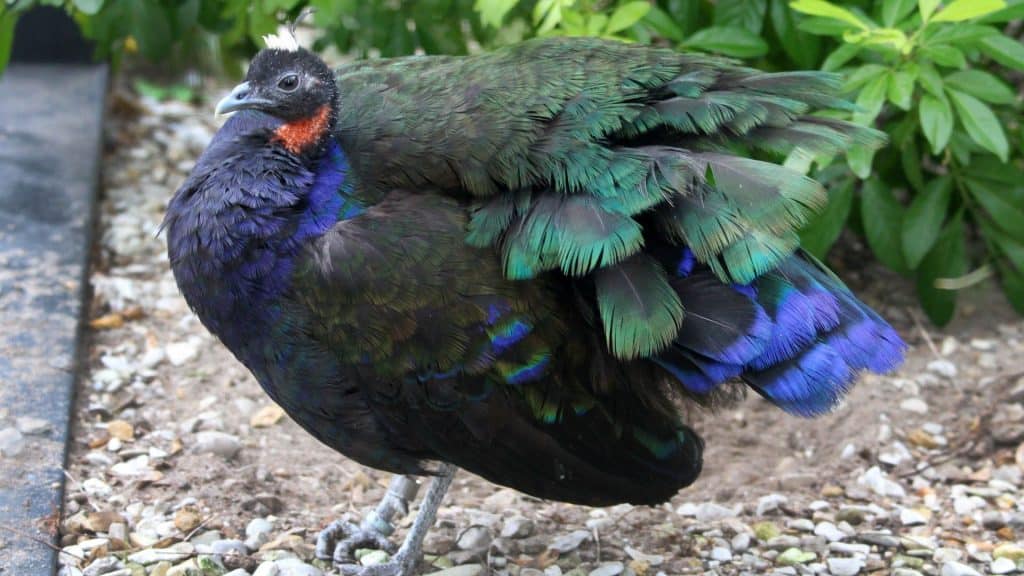
Congo peacocks are known for their unique appearance. They are the only peacock species found along the Congo Basin in Africa, dotted with large swaths of rainforests.
Congo Peafowl looks like a hybrid version of turkeys and Indian peacocks. They do not have a unique and vibrant display of colors like the Indian and Java species. Their wings have an emerald green sheen, and their upper body is bright blue. They share many characteristics with turkeys, grouse, pheasants, and partridges.
How Long Peacocks Take to Develop Colorful Tail Feathers
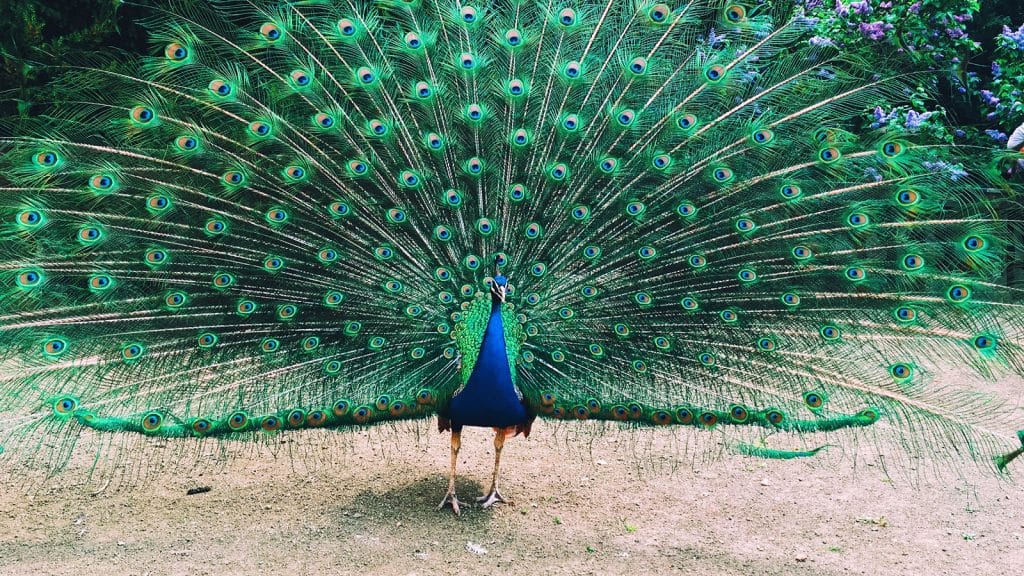
The beautiful tail feathers of peacocks take time to grow. When female and male peacocks are born, they look identical. Even during their initial growing phase, there are not many differences between them because they do not develop colorful tail feathers until then. A male starts developing color at three months old, and its tail feathers fully develop only when it reaches maturity.
The development and growth of tail feathers occurs during molting, which is the shedding of the old feathers and replacement with new ones. Peacocks undergo a yearly molting cycle where they replace their old feathers with new ones.
During this process, the deposition of colorful pigments occurs on the feathers. Because of this, peacocks take years to develop colorful tail feathers. It is also important to note that just like dogs shed their fur and old dead skin, the peacock also loses feathers. They need specialized care to ensure their tail feathers keep looking magnificent.
Various Characteristics of Peacock
1. Height and Weight
Male peacocks measure up to 2.3 meters in length, while females are around 86 centimeters in length. The male Peafowl’s tail length can be around 4 – 5 feet. Males weigh 8 to 13 pounds and have a wingspan of around 51 to 63 inches. Females weigh 6 to 8.8 pounds and have a wingspan of 31 to 51 inches.
2. Appearance
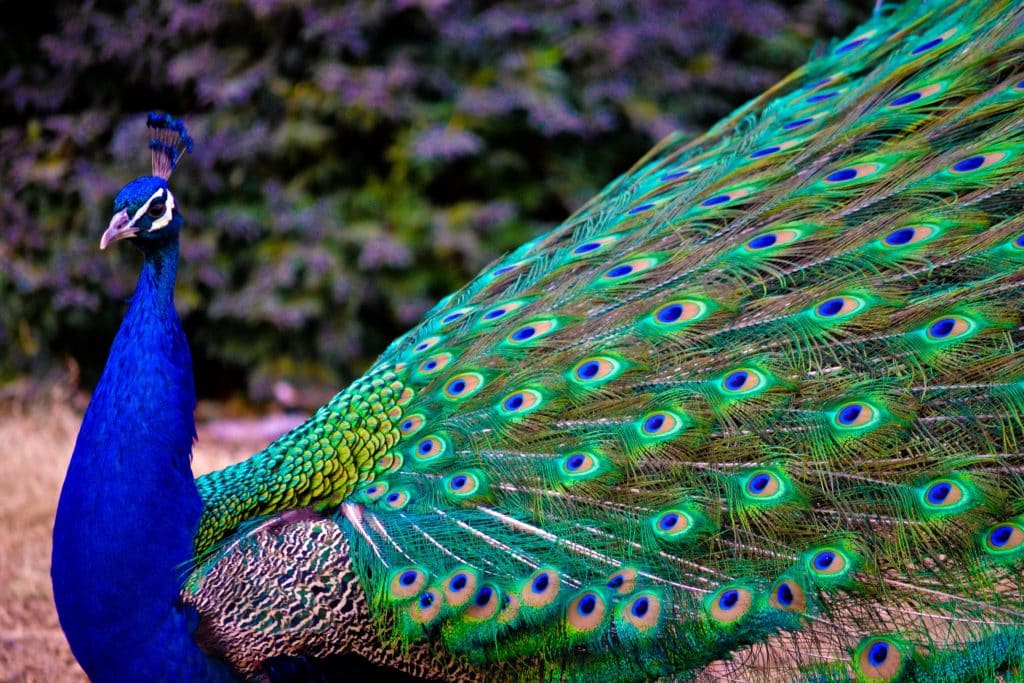
Peacocks are one of the most majestic creatures on Earth. They are known for their colorful and vibrant appearance, with their iridescent gold, green, and blue feathers that catch everyone’s attention. Male peacocks mainly use these feathers to attract female peahens. One of the most recognizable features of the male peacock is that lengthwise; its tail can reach up to 6 feet. Females are not as colorful and bright as the males. They have a duller appearance and lighter underparts. Peahens also do not have long upper tail coverts. They are brown with an iridescent green shade on their neck.
Both female and male Peafowl have crests on the upper portion of their heads. This is especially evident in the Green Peafowl species. The Indian Peafowl and Green Peafowl look distinct. The male has gold and green plumage and black wings with a sheen of blue. The upper tail feather coverts of Green Peahens are shorter and slightly less iridescent. When the male doesn’t have a train, it becomes difficult to differentiate them from the females.
3. Diet & Habitat
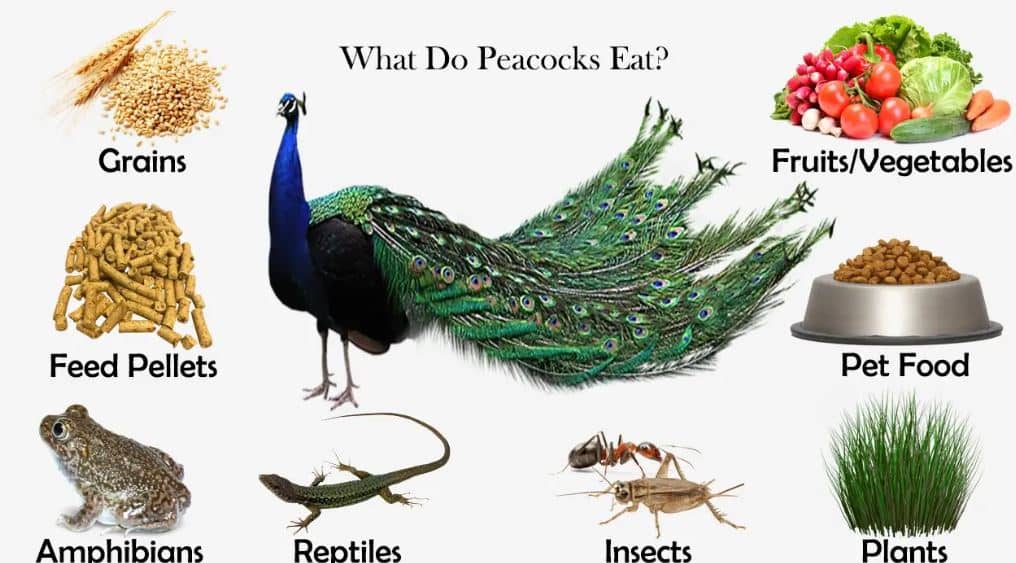
Peacocks are omnivores and eat insects, small mammals, seeds, grains, flowers, small reptiles, fruits and berries. The most common food that peacocks like to eat is grains. Peacocks also like to eat small reptiles, like amphibians, young cobra snakes, butterflies, chickens, mice, voles and flies. However, peafowls feed all kinds of edible items, whether it’s a plant or an animal source. When they are feeding, they mostly remain on the ground.
Peacocks are most commonly found in South Asia and countries like Pakistan, India, and Sri Lanka. Peafowl live in agricultural fields, farms, and forested areas. They can also be found in deciduous forests, lowland forests, and dry and tropical habitats. They prefer to live in wooded areas where they can get proper access to water. Peafowl can also be found near human settlements. In captivity, they are kept in private collections, botanical gardens, and zoos.
4. Breeding
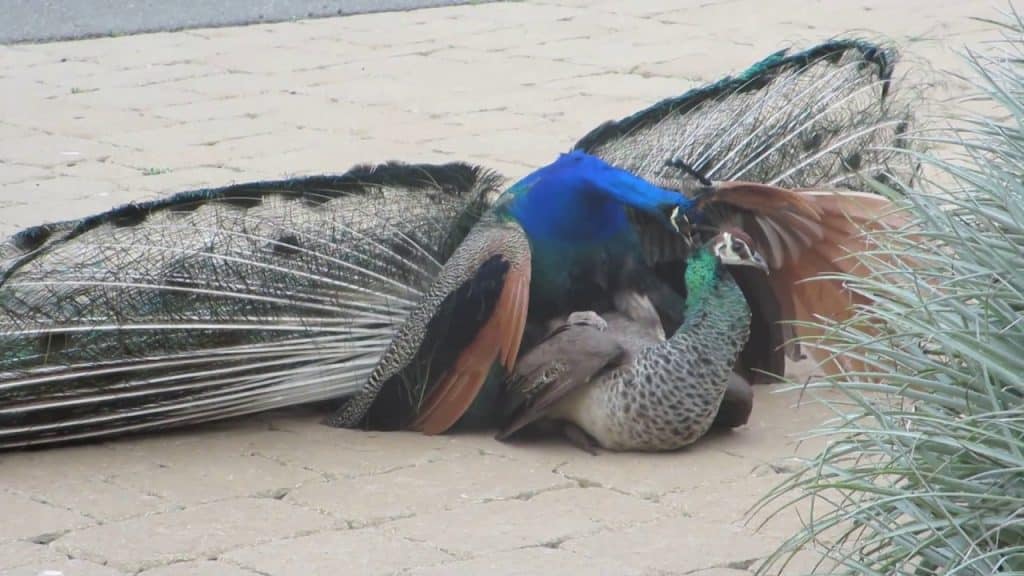
Peafowl are known to be polygynous birds, meaning in a season, the male mates with multiple females. In captivity, the green peafowl forms monogamous pairs and mates with only one female throughout his life. Wild peahens become very aggressive with each other when competing to mate with a dominant male. It mates repeatedly with the dominant peacock to lower other females’ mating attempts. Peacocks establish small territories close to one another from mid to late spring. This arrangement is called lek.
Peacocks try to attract the peahens with the help of their courtship displays. They spread their iridescent tail feathers, strut back and forth, and shake their feathers to get the attention of peahens. Before selecting a mating partner, peahen walks through the territories of different males, checking out their feathers and displays closely.
The breeding age of peahens is around 2 years, and peacocks are around 3 years. From April to September, peahens lay six to twelve buff-colored, brownish eggs. The eggs are laid in a grass-lined nest and scratched in the ground. The Peahen sits upon the eggs and incubates them for twenty-eight days.
5. Lifespan & Threats
In the wild, the lifespan of peafowl and peacocks is estimated to be around 10 to 25 years. In captivity, peafowl can live for longer than 30 to 50 years.
Because the peacock is an ornamental bird, they do not have any effective means of self-defense. If you’re raising a peacock in captivity, you must try to defend it from predators. In the wild, the peafowl keeps away from predators by roosting in a tree overnight. To protect peacocks, you should keep predators out of the area and give them a method to escape, such as a tree or any high place where they can fly when they sense any danger.
Harvesting, mining, animal agriculture, and food shortages from other species displacement are also the common reasons behind the habitat loss of peacocks. The green peafowl is an endangered species, and the African Congo peafowl is vulnerable.
6. Conservation Status
The conservation status of peafowl typically depends on species. IUCN has identified the Indian peacock’s conservation status as “least concern.” Indian Peacock is present in a large number across Southeast Asia, and their estimated population is over 100,000. IUCN has listed the Congo peafowl as decreasing in population. They were estimated to be around 2,500 and 10,000 in 2016. IUCN has listed green peafowl as endangered. In the wild, there are fewer than 20,000 mature birds, and their population is decreasing daily.
Some Brilliant Facts About Peacocks
- Peahen is the female, and Peacock is the male bird, and together, they are called peafowl. Their offspring are known as peachicks.
- There are mainly three species of peacock, namely the Green peacock, the African Congo peacock, and the Indian peacock. All these species are originally from Asia, but they can also be found in Africa and Australia.
- When the mating period is over, a peacock undergoes a molting process wherein it naturally sheds its feathers and regrows them more luscious and longer before the next mating season.
- A unique thing about a peacock’s feather is that when the light strikes from different angles, it changes its color. This is because their feathers contain microscopic ‘crystal-like structures’ which reflect different wavelengths of light.
- Most peacocks die as chicks. The mortality rate of peachicks is around 50%. Until peachicks are a few months old, they are very vulnerable.
- The Congo peafowl doesn’t look as alluring as the Blue and Green peafowl. The feathers of a Congo peacock are deep blue with a violet and metallic green tinge.
Conclusion
Peacocks are one of the most adorable creatures known for their beauty. They feature beautiful feathers, a huge tail, and fascinating patterns on their bodies. They prefer to live in jungles, agricultural lands, and other wooded areas where they can get water.
There are three common species of peacock birds: green peafowl, blue peafowl, and Congo peafowl. They can’t fly for a long time, unlike the other birds, and remain on the ground during the daytime and keep away from predators by roosting in a tree overnight. The peacock feather is considered auspicious, and many people keep it in their homes to bring good luck and prosperity.
You can check the above facts to learn more about these majestic creatures.
Frequently Asked Questions
Do Peacocks have Teeth?
No, peacocks do not have teeth, but they possess a sharp, pointy beak to hunt their prey. They also use their beak to eat food. Their beaks are very sharp and can easily crack nuts, attack, or scratch during the mating season.
What is the Cultural Significance of peacocks?
The Indian Blue Peafowl is known to be the mount of the god of war. Peacock feathers can also be found on Lord Krishna’s crest. The peacock drawing symbolizes vanity and pride. In Persia, peacocks are engraved upon royal thrones as they are considered guardians of loyalty.
Are Peacocks Killed for Their Feathers?
Peacocks are not killed for their feathers as they shed their feathers every year in a process called molting. The shedding process starts after the mating season between August and February.
Can Peacocks Survive in Cold Climates?
Peafowls are native to warmer regions, but they have also been introduced to colder climates. They will need protection and shelter during colder weather as they enjoy warmer climates more.
Can Peacocks Fly?
Peacocks can fly, but their flight is limited. They can’t cover long distances and fly for a long time, unlike the other birds. They use their strong and long wings to fly short distances and reach higher perches to escape predators.

